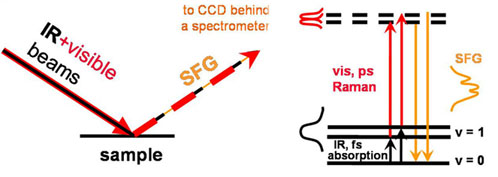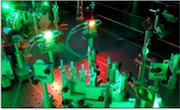Accueil > Équipes scientifiques > Nanophysique et Surfaces (Nanophys) > Techniques expérimentales et théoriques > Vibrational spectroscopy by Sum Frequency Generation (SFG)
Vibrational spectroscopy by Sum Frequency Generation (SFG)
Vibrational spectroscopy by sum frequency generation (SFG) is a non-linear optical spectroscopy method for probing the vibrational properties of molecules on surfaces or interfaces of different natures (solid/air, liquid/air, solid/liquid). SFG, sensitive to the environment, makes it possible to determine the adsorption sites of the molecule, its orientation, the influence of neighboring molecules over a wide range of pressures ranging from ultra-high vacuum (10-10 mbar) to atmospheric pressure.

It consists of spatially and temporally superimposing two laser pulses, one of which resonates with the vibrational states of the molecule. It also allows the study of the dynamics of interactions at a time scale of the order of 50 fs in the context of pump-probe experiments. For this, a third pulse, whose delay with the probe is adjusted, induces a perturbation of the system (hot electrons in the substrate or electronic states of the molecule) and the SFG (probe) for different delays, then gives access to the vibrational dynamics of the system.

A femtosecond laser chain renewed in 2021 (Inauguration 4th of April 2022) comprising 3 optical parametric amplifiers, covers wavelengths from near UV (0.24 µm) to mid-IR (16 µm) with pulse durations ranging from 35 fs to 3 ps, is used to perform the SFG experiments. Characterization means include spectrometers, auto-correlators, FROG, wavefront meter (HASO) and PHAZZLER. These tools are shared between different ISMO teams (Nanophys, DIRAM, SYSIPHE, SYSTEMAE) for experiments in non-linear optical spectroscopy of electronic or vibrational states in the gas phase, on surfaces or in cryogenic matrices.
For more information on the SFG and the related scientific themes, please consult the page of the group "Femtophysics at interfaces" or the thematic axes Ultrafast dynamics and Ultrathin layers & Nanostructuring from the team Nanophysics@Surfaces (Nanophys)
Dans la même rubrique :
- De l’optique « en plein champ » avec un microscope à effet tunnel
- Spectroscopie vibrationnelle par génération de fréquence somme (SFG)
- Le Tunnel : combiner des techniques de sciences des surfaces sous vide
- Voir des surfaces avec des atomes : “grazing incidence fast atom diffraction” (GIFAD)
- Le microscope à effet tunnel à basse température
- Outils de calcul


